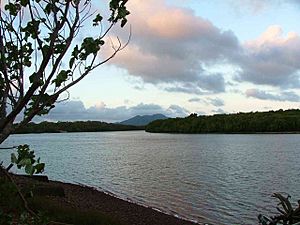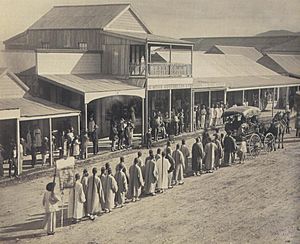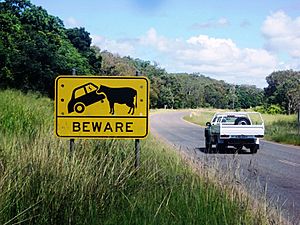Cooktown, Queensland facts for kids
Quick facts for kids CooktownQueensland |
|||||||||||||||
|---|---|---|---|---|---|---|---|---|---|---|---|---|---|---|---|

View of Cooktown from Grassy Hill
|
|||||||||||||||
| Population | 2,746 (2021 census) | ||||||||||||||
| • Density | 1.24972/km2 (3.2368/sq mi) | ||||||||||||||
| Postcode(s) | 4895 | ||||||||||||||
| Elevation | 6.0 m (20 ft) | ||||||||||||||
| Area | 2,197.3 km2 (848.4 sq mi) | ||||||||||||||
| Time zone | AEST (UTC+10:00) | ||||||||||||||
| Location |
|
||||||||||||||
| LGA(s) | Shire of Cook | ||||||||||||||
| County | Banks | ||||||||||||||
| State electorate(s) | Cook | ||||||||||||||
| Federal Division(s) | Leichhardt | ||||||||||||||
|
|||||||||||||||
|
|||||||||||||||
Cooktown is a town on the coast in Queensland, Australia. It is located at the mouth of the Endeavour River on the Cape York Peninsula. This is where James Cook landed his ship, the Endeavour, for repairs in 1770. Both the town and the nearby Mount Cook (431 meters tall) are named after him.
Cooktown is one of the main towns in the Cape York Peninsula. It was started on October 25, 1873. The town was a supply port for the goldfields along the Palmer River. It was first called "Cook's Town" until June 1, 1874. In 2021, about 2,746 people lived in Cooktown.
Contents
Exploring Cooktown's Location
Cooktown is about 2,000 kilometers (1,240 miles) north of Brisbane. It is also about 328 kilometers (204 miles) north of Cairns by road. From Cooktown, it's about 857 kilometers (533 miles) south of Cape York by road.
The town sits where the Endeavour River meets the sea. This area is part of the Cape York Peninsula in Far North Queensland. The rugged Mount Cook (431 meters or 1,415 feet) stands behind the town. It was named by Phillip Parker King in 1818.
The area around Cooktown has many different kinds of plants and animals. It's close to three major natural areas. This means it has a large number of the 3,000 plant species found on Cape York Peninsula. More than 500 types of land animals also live here. Many rare or unusual species can be found, which makes the region very interesting for scientists.
A Look Back at Cooktown's History
Early Aboriginal History
The local Guugu Yimithirr language name for this area is Gangaar. This means "(Place of the) Rock Crystals." Aboriginal people used quartz crystals in their ceremonies. These crystals were traded from the Cooktown region to places far away.
Captain Cook's Arrival
In June 1770, the local Guugu Yimithirr people watched a damaged ship arrive. It was James Cook's ship, the Endeavour. The ship was badly hurt after hitting a reef south of Cooktown. It needed a safe place to land for repairs. The Guugu Yimithirr people saw the Endeavour land in the calm waters of their river, which they called "Wahalumbaal."
Captain Cook wrote that it was lucky they found such a safe place. He said they had not seen any other place on their journey that could have helped them so much.
The British crew stayed for seven weeks where Cooktown is now. They fixed their ship and got more food and water. They also took care of their sick crew members. Joseph Banks, a scientist, and Daniel Solander, a naturalist, were with Cook. They collected and studied over 200 new types of plants. The artist Sydney Parkinson drew these plants. He was also the first British artist to draw Aboriginal people after seeing them.
After some weeks, Joseph Banks met and talked with the local people. He wrote down about 50 words from the Guugu Yimithirr language. This included the name of an interesting animal the locals called gangurru. This is where the word "kangaroo" comes from! The first time Europeans saw kangaroos was on Grassy Hill. Cook climbed this hill to find a safe way for his ship to sail after it was fixed.
An important event happened on July 19, 1770. After Cook refused to share turtles with the local people, they set fire to the grass around his camp. Cook wounded one of the men. Later, a "little old man" from the Aboriginal group came forward. They made peace at a place now called Reconciliation Rocks. This is believed to be the first recorded act of reconciliation between Europeans and Indigenous Australians.
Cook named the river the "Endeavour" after his ship. As they sailed north, he claimed the whole eastern coast of Australia for Britain. He named Cape York Peninsula after the Duke of York.
The Gold Rush Era
In 1872, William Hann found gold in the Palmer River. This led to a huge gold rush in 1873. People came from all over the world to find gold. Cooktown was founded as the main port for these goldfields. It was where gold was sent out and supplies were brought in.
By 1880, Cooktown was a busy town. It had about 4,000 permanent residents and many more people in the area. There were many hotels, bakeries, and shops. A large Chinese community also grew in the goldfields and in Cooktown. They came as gold seekers but also started farms and shops. They supplied the town with food like fruit, vegetables, and rice.
However, there were many problems between the Aboriginal people and the new settlers. The Aboriginal people fought back against the newcomers. But it was a very unequal fight. Many Aboriginal groups were lost as Europeans settled across Cape York Peninsula.
In 1887, Chinese officials visited Cooktown. They came from Canton to see how Chinese people were living in the area. The visit went well, and everyone was happy.
Transport to the goldfields was difficult. It often took three weeks to get supplies there. A railway line was planned from Cooktown to Maytown. But it only reached Laura, about 67 kilometers (42 miles) away. By then, the gold was running out. The railway closed in 1961 after a new road was built.
Cooktown's beautiful Botanic Garden was started in 1878. It had wells, paths, and many plants. Even though it fell into disrepair, it has been restored. Now, it's a popular place for nature lovers. Walking tracks lead to lovely beaches like Finch Bay.
In 1886, Lutheran missionaries came to help Aboriginal people living near the town. They set up missions at Hopevale and Wujal Wujal. Also, in 1888, Irish nuns from the Sisters of Mercy started a Catholic school. This building is now the James Cook Museum.
By 1893, Cooktown was a busy place with about 2,000 people. But after the gold rush ended, the town's population began to shrink. Two big fires in 1875 and 1919 destroyed many buildings. A major cyclone in 1907 also caused a lot of damage.
Cooktown in World War II
During the Second World War, Cooktown became an important military base. Most people living in Cooktown were asked to leave for safety. By 1942, many had gone. Aboriginal people from the missions at Hope Vale and Bloomfield were also moved from their homes. Many were taken south, and some elderly people went to Palm Island. They were not allowed to return until 1949. Many Aboriginal people died after being moved from their traditional lands.
About 20,000 Australian and American soldiers were based in Cooktown. The airfield there was very important in the Battle of the Coral Sea. This battle stopped Japanese forces from moving towards Australia. The last military group left Cooktown in 1946.
Cooktown Today
In 1949, another cyclone hit the town, and Cooktown's population dropped even more. After the railway closed in 1961, the town became very small. But slowly, it started to grow again.
Today, Cooktown is a popular place for tourists. The Mulligan Highway is now paved, making it easier to reach by road. There are also two flights a day connecting Cooktown with Cairns. The town has good services and roads. It offers a relaxed and healthy lifestyle.
Fewer than 2,000 people live in the town itself. But about 4,000 more people in the area use Cooktown for services. Visitors enjoy the tropical weather and the town's history. It's also a good starting point for visiting the Great Barrier Reef and Lakefield National Park.
Cooktown has a public library, a swimming pool, and sports clubs. There's also a historic cemetery and a Chinese shrine. The Cooktown Museum and Botanic Gardens are popular spots. The heritage-listed Grassy Hill lighthouse offers great views. A new Events Centre next to the Cooktown State School can also be used as a cyclone shelter.
The Information Centre is in Nature's Powerhouse in the Botanic Gardens. It has displays about local plants and animals. Vera Scarth-Johnson, a local artist, gave her amazing drawings of plants to Cooktown. These are now shown at Nature's Powerhouse.
Cooktown is a service center for nearby Aboriginal communities. These include Hopevale, 47 kilometers (29 miles) northwest, and Wujal Wujal, 72 kilometers (45 miles) south.
The "Milbi Wall" (or "Story Wall") shows the first meeting between British sailors and the local Aboriginal people. The Milbi Wall tells the story of Cooktown from the Aboriginal perspective. It is a great symbol of reconciliation.
Cooktown is the northern end of the Bicentennial Heritage Trail. This trail is 5,330 kilometers (3,312 miles) long, making it the longest of its kind in the world.
Places of Interest
Cooktown has many places that are important for their history. These are called heritage-listed sites:
- Adelaide, Charlotte, Furneaux, Green, Helen, Hogg, Hope and Walker Streets and Webber Esplanade: Early Granite Kerbing and Channelling
- 120 Charlotte Street: Westpac Bank Building
- 121 Charlotte Street: Cook Shire Council Chambers (now Cooktown History Centre)
- 124 Charlotte Street: Seagren's Building
- 126 Charlotte Street: Ferrari Estates Building
- Charlotte Street: Cooks Monument and Reserve
- Charlotte Street: Cooktown Cemetery
- Charlotte Street: Mary Watson's Monument
- Finch Bay Road: Gallop Botanic Reserve, incorporating Cooktown Botanic Gardens
- Furneaux Street: Cooktown Museum (formerly James Cook Historical Museum)
- Grassy Hill: Grassy Hill Light
- Helen Street: Cook Shire Hall
- May Street: Old Cooktown Hospital (now Jehovah's Witness Kingdom Hall)
- Webber Esplanade: Cooktown Powder Magazine
Schools in Cooktown
Cooktown has several schools for students:
- Cooktown State School is a government school for students from Prep to Year 12. It is located at Cnr May & Charles Streets. In 2018, it had 394 students.
- Endeavour Christian College is a private school for students from Prep to Year 11. It is at 12 Charles Street. In 2018, it had 126 students.
- Holy Spirit College is a Catholic school for secondary students (Years 7–10). It is at the corner of Hope and Burkitt Streets. In 2018, it had 85 students.
Community Services
The Cook Shire Council runs a public library at 33 Helen Street. The Cooktown branch of the Queensland Country Women's Association meets at 107 Charlotte Street. There is a Police-Citizens Youth Club (PCYC) at 3 May Street. It has a gym and rooms for events. St Mary's Catholic Church is at 8 Furneaux Street. Cooktown also has a bowling green, swimming pool, golf, tennis, and turf clubs. There's a historic cemetery and a Chinese shrine. The Cooktown Museum and Botanic Gardens are popular. The heritage-listed Grassy Hill lighthouse is also a key spot. An active Aboriginal Community Centre called Gungarde is on the main street. Its name comes from the original Guugu Yimithirr name for the area.
Local Events

The Cooktown Re-enactment Association has been performing a re-enactment of Cook's 1770 landing since 1959. Many local Guugu Yimithirr people support this tradition. They celebrate the first act of reconciliation between Indigenous and non-Indigenous people. This is based on the story when a Guugu Yimithirr elder made peace with Cook. He offered Cook a broken spear as a sign of peace. This stopped possible conflict.
Cooktown planned an "Expo 2020" festival to celebrate 250 years since Cook's arrival. However, due to the COVID-19 pandemic in Australia, it was moved to 2021. It was meant to include a big music festival and a visit from the replica of Cook's ship, the HM Bark Endeavour Replica.
Cooktown's Weather
Cooktown has a tropical savanna climate. This means it has a wet season and a dry season. The wet season is from December to April. It is usually hot and humid, but sea breezes and rain help keep temperatures down. The dry season is from May to November. It is less hot and humid. Even in the dry season, winds from the sea can bring some light rain.
| Climate data for Cooktown Post Office | |||||||||||||
|---|---|---|---|---|---|---|---|---|---|---|---|---|---|
| Month | Jan | Feb | Mar | Apr | May | Jun | Jul | Aug | Sep | Oct | Nov | Dec | Year |
| Record high °C (°F) | 41.7 (107.1) |
38.3 (100.9) |
37.8 (100.0) |
37.2 (99.0) |
32.4 (90.3) |
31.6 (88.9) |
31.0 (87.8) |
31.1 (88.0) |
34.2 (93.6) |
35.5 (95.9) |
39.4 (102.9) |
38.6 (101.5) |
41.7 (107.1) |
| Mean daily maximum °C (°F) | 31.4 (88.5) |
31.2 (88.2) |
30.3 (86.5) |
29.1 (84.4) |
27.6 (81.7) |
26.2 (79.2) |
25.7 (78.3) |
26.4 (79.5) |
27.7 (81.9) |
29.3 (84.7) |
30.7 (87.3) |
31.5 (88.7) |
28.9 (84.0) |
| Mean daily minimum °C (°F) | 24.3 (75.7) |
24.1 (75.4) |
23.9 (75.0) |
23.1 (73.6) |
21.7 (71.1) |
19.9 (67.8) |
19.2 (66.6) |
19.7 (67.5) |
21.2 (70.2) |
22.7 (72.9) |
23.9 (75.0) |
24.3 (75.7) |
22.3 (72.1) |
| Record low °C (°F) | 17.2 (63.0) |
20.0 (68.0) |
18.9 (66.0) |
16.3 (61.3) |
12.2 (54.0) |
10.0 (50.0) |
4.4 (39.9) |
11.0 (51.8) |
14.1 (57.4) |
14.1 (57.4) |
16.1 (61.0) |
20.0 (68.0) |
4.4 (39.9) |
| Average rainfall mm (inches) | 375.6 (14.79) |
377.6 (14.87) |
389.4 (15.33) |
218.3 (8.59) |
78.7 (3.10) |
50.2 (1.98) |
26.9 (1.06) |
30.0 (1.18) |
16.3 (0.64) |
22.1 (0.87) |
61.6 (2.43) |
162.7 (6.41) |
1,809.4 (71.25) |
| Average rainy days (≥ 0.2 mm) | 17.1 | 17.9 | 18.4 | 15.0 | 12.1 | 8.7 | 7.2 | 6.9 | 4.5 | 4.2 | 6.6 | 10.9 | 129.5 |
| Average relative humidity (%) | 79 | 82 | 80 | 76 | 76 | 76 | 75 | 73 | 69 | 68 | 69 | 72 | 75 |
| Source: Australian Bureau of Meteorology | |||||||||||||
Images for kids
See also
 In Spanish: Cooktown para niños
In Spanish: Cooktown para niños








